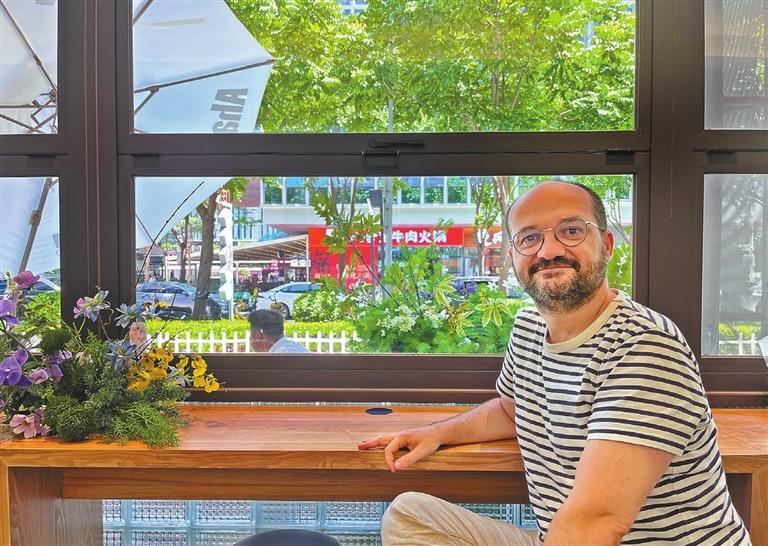
Zhang Yu JeniZhang13@163.com WHEN French gaming veteran Damien Poussé planned his return to China in February 2022, Guangzhou was the destination, as Chinese internet giant NetEase had recruited him for a strategic role there. But six months later, pandemic flight cancellations and a scrapped project rerouted him to Shenzhen. For Poussé — a creative director with 15 years at Ubisoft, including a previous one-year-and-a-half-year stint in Shanghai — this detour has unexpectedly redefined his career. Now, two and a half years later, the industry veteran navigates dual transformations: rebuilding his career at AI and 3D technology services company XVERSE while embracing fatherhood with his months-old baby. “It’s a new life,” laughed the accidental Shenzhener, whose journey mirrors the city’s own reinvention — unexpected, fast-paced, and relentlessly forward-looking. Gaming’s great divide As a seasoned gaming industry professional with over a decade of experience, Poussé has observed China’s gaming ecosystem to be impressive in its dynamism. The sector is currently experiencing an unprecedented surge, characterized by a constant influx of innovative projects and concepts. He highlights China’s distinct gaming model centered on free-to-play service games, contrasting sharply with the triple-A games (high-budget, one-time purchase for PC/consoles) dominant in Western countries. He notes these “service games” prioritize continuous content updates, allowing players to engage with the same title for years. Mobile platforms dominate this market, and the rapid pace of releasing new content represents a uniquely Chinese approach to game development. “There are many mobile games. In my view, the fast-paced approach of free-to-play models with continuous content updates is particularly characteristic of Chinese companies,” Poussé shared with Shenzhen Daily. Meanwhile, cultural differences significantly shape design philosophies, particularly for characters. Poussé observes that Western studios increasingly create flawed, relatable heroes, while Chinese and broader Asian markets favor idealized archetypes — beautiful women and handsome men who embody perfection. These diverging expectations necessitate ongoing dialogue between developers to align creative visions. The French game designer has also noticed that younger audiences are increasingly seeking more diverse characters — ones that feel relatable rather than idealized. “I think it’s a very interesting topic for me. How do we build characters? How do we craft heroes? How do we design games that speak to everyone?” According to Poussé, China’s gaming industry shows signs of evolution with “Black Myth: Wukong” — the first-ever made-in-China triple-A game. He identified this premium, narrative-driven game as a potential turning point. “I’m very interested in seeing how it’s going to be followed, and how many Chinese games like this are going to be successful.” In addition, gaming’s pervasiveness in daily Chinese life stands out to Poussé. He observes broader player engagement compared to Western audiences, with groups often playing together in cafes. “Everyone plays some form of games, whether simple casual games or complex ones like ‘Honor of Kings,’” he said, adding that he feels like Chinese gamers are somewhat more gaming-oriented than Western audiences. SZ: The convenient frontier Poussé’s 15-year tenure at French gaming giant Ubisoft contrasts sharply with his Shenzhen experience. “In France, it’s quite common to have a drink with colleagues after work,” he said. “Here it’s always fast-paced. Projects have to launch quickly. I think the overall city has this kind of fast pace that you feel pushed all the time when you work.” He considers Shenzhen as a city where modern efficiency and natural accessibility coexist — a place where skyscrapers meet the sea, and convenience fuels resilience in a high-pressure environment. “Shenzhen is a very convenient city. Even if you work a lot, you can find things to do. You can find places to go outside, and you have lots of nice places to visit around Shenzhen,” he shared. Having grown up on France’s Atlantic coast, Poussé cherishes Shenzhen’s waterfront access, specifically mentioning Shenzhen Bay for cycling and walks. “I love to live by the sea and see the sea every day.” Poussé’s connection to Chinese culture remains strong. He actively participated in community activities – Cantonese and cooking classes, lychee-picking activity — finding connection with fellow expats and deeper cultural understanding. The French game designer roots himself through language study and curiosity. His advice to newcomers? “Learn Chinese. Be curious. Everyone here comes from other parts of China — each has a story.” | 
